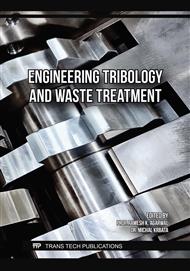[1]
R. Romano, A. Santini, L. Le Grottaglie, N. Manzo, A. Visconti, and A. Ritieni, "Identification markers based on fatty acid composition to differentiate between roasted Arabica and Canephora (Robusta) coffee varieties in mixtures," Journal of Food Compostion and Analysis 35 (2014) 1-9
DOI: 10.1016/j.jfca.2014.04.001
Google Scholar
[2]
N. Martinez-Saez et al., "Use of spent coffee grounds as food ingredient in bakery products," Food Chemistry 216 (2017) 114-122
DOI: 10.1016/j.foodchem.2016.07.173
Google Scholar
[3]
P. S. Murthy and M. M. Naidu, "Sustainable management of coffee industry by-products and value addition—A review," Resources, Conservation and Recycling 66 (2012) 45-58
DOI: 10.1016/j.resconrec.2012.06.005
Google Scholar
[4]
D. Peshev, D. Mitev, L. Peeva, and G. Peev, "Valorization of spent coffee grounds–A new approach," Separation and Purification Technology 192 (2018) 271-277
DOI: 10.1016/j.seppur.2017.10.021
Google Scholar
[5]
S. K. Karmee, "A spent coffee grounds based biorefinery for the production of biofuels, biopolymers, antioxidants and biocomposites," Waste Management 72 (2018) 240-254
DOI: 10.1016/j.wasman.2017.10.042
Google Scholar
[6]
L. F. Ballesteros, M. A. Cerqueira, J. A. Teixeira, and S. I. Mussatto, "Characterization of polysaccharides extracted from spent coffee grounds by alkali pretreatment," Carbohydrate Polymers 127 (2015) 347-354
DOI: 10.1016/j.carbpol.2015.03.047
Google Scholar
[7]
M. López-Silva and D. E. García-Valle, "Ice cream cone fortified with spent coffee ground: Chemical composition, quality and sensory characteristics, and in vitro starch digestibility," Food Chemistry 459 (2024) 140288
DOI: 10.1016/j.foodchem.2024.140288
Google Scholar
[8]
S. Salsabila, S. Kerdpiboon, W. L. Kerr, and T. Puttongsiri, "Drying Effects on Physicochemical and Functional Properties of Cuttlefish (Sepia officinalis) Ink Powder," Journal of Agriculture and Food Research (2024) 101250
DOI: 10.1016/j.jafr.2024.101250
Google Scholar
[9]
V. P. Gouw, J. Jung, and Y. Zhao, "Functional properties, bioactive compounds, and in vitro gastrointestinal digestion study of dried fruit pomace powders as functional food ingredients," LWT 80 (2017) 136-144
DOI: 10.1016/j.lwt.2017.02.015
Google Scholar
[10]
W. Xu et al., "Preparation and characterization of tea oil powder with high water solubility using Pickering emulsion template and vacuum freeze-drying," LWT 160 (2022) 113330
DOI: 10.1016/j.lwt.2022.113330
Google Scholar
[11]
AOAC: Official Methods of Analysis of the Association of Official Analytical Chemists. Arlington: Association of Official Analytical Chemists. Inc., 2011.
DOI: 10.5962/bhl.title.44636
Google Scholar
[12]
S. I. Mussatto, L. F. Ballesteros, S. Martins, and J. A. Teixeira, "Extraction of antioxidant phenolic compounds from spent coffee grounds," Separation and Purification Technology 83 (2011) 173-179
DOI: 10.1016/j.seppur.2011.09.036
Google Scholar
[13]
Y. F. Shang, J. L. Xu, W. J. Lee, and B. H. Um, "Antioxidative polyphenolics obtained from spent coffee grounds by pressurized liquid extraction," South African Journal of Botany 109 (2017) 75-80
DOI: 10.1016/j.sajb.2016.12.011
Google Scholar
[14]
M. Zainol, I. Mohd Subri, A. Zamri, Z. Mohd Zin, A. Fisal, and H. Mamat, "Antioxidative properties and proximate analysis of spent coffee ground (SCG) extracted using ultrasonic-methanol assisted technique as a potential functional food ingredient," Food Research 4 (2020) 636-644
DOI: 10.26656/fr.2017.4(3).358
Google Scholar
[15]
V. Sinija and H. Mishra, "Moisture sorption isotherms and heat of sorption of instant (soluble) green tea powder and green tea granules," Journal of Food Engineering 86 (2008) 494-500
DOI: 10.1016/j.jfoodeng.2007.10.026
Google Scholar
[16]
D. Nowak and E. Jakubczyk, "The freeze-drying of foods—The characteristic of the process course and the effect of its parameters on the physical properties of food materials," Foods 9 (2020) 1488
DOI: 10.3390/foods9101488
Google Scholar
[17]
M. Montemurro, M. Casertano, A. Vilas-Franquesa, C. G. Rizzello, and V. Fogliano, "Exploitation of spent coffee ground (SCG) as a source of functional compounds and growth substrate for probiotic lactic acid bacteria," LWT 198 (2024) 115974
DOI: 10.1016/j.lwt.2024.115974
Google Scholar
[18]
W. Sunarharum, S. Yuwono, and O. Aziza, "Study on the effect of roasting temperature on antioxidant activity of early-roasted Java coffee powder (Arabica and Robusta)," IOP Conference Series: Earth and Environmental Science 230 (2019) 012045
DOI: 10.1088/1755-1315/230/1/012045
Google Scholar
[19]
E. Kim, Y. Jeong, S. Gu, K.-Y. Song, I. Kim, and K.-Y. Kim, "Physicochemical characteristics of Brazilian Coffea arabica cv. Catuai coffee extracts with different roasting conditions," Journal of the Korean Society of Food Science and Nutrition 48 (2019) 748-756
DOI: 10.3746/jkfn.2019.48.7.748
Google Scholar
[20]
F. Al Juhaimi et al., "The effects of conventional heating on phenolic compounds and antioxidant activities of olive leaves," Journal of Food Science and Technology 55 (2018) 4204-4211
DOI: 10.1007/s13197-018-3356-y
Google Scholar


